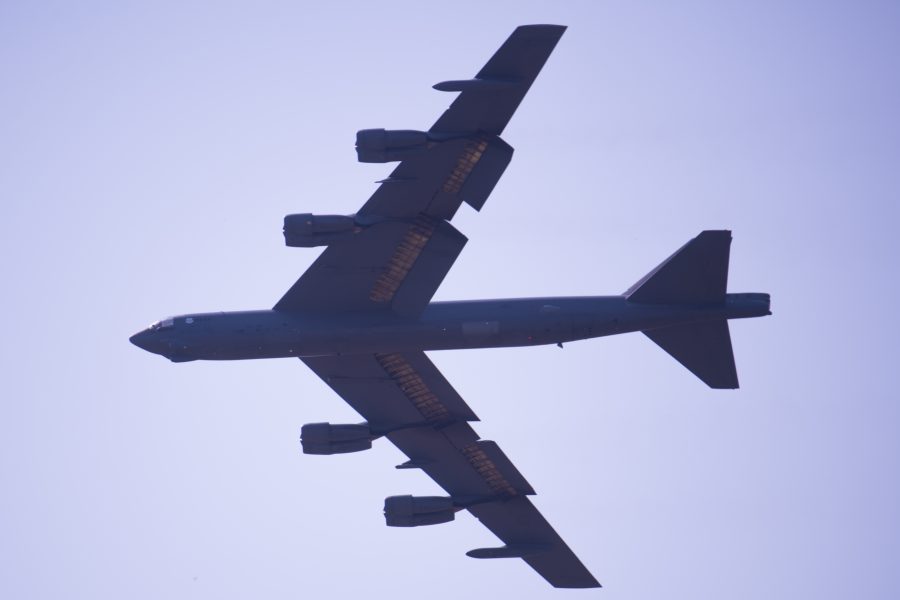Barksdale Air Force Base, La., suffered light damage and no injuries or deaths due to Hurricane Laura, which passed close to the base early on Aug. 27.
Damage at the base was reported as light to moderate, mostly due to fallen trees, with some wind damage to buildings and flooding in low-lying areas. The highest wind speed recorded at the base was 55 miles per hour, according to a base spokesman, but nearby Shreveport experienced winds in excess of 90 mph. A comprehensive evaluation of damage will take a few days.
The 2nd Bomb Wing relocated its B-52s to Minot Air Force Base, N.D., throughout the day on Aug. 26, up until just a few hours before the storm arrived. Minot—Global Strike Command’s other B-52 base—had space because six of its B-52s recently deployed to Europe. Barksdale has about 47 Stratofortresses, but base officials declined to say how many moved and how many remained behind due to maintenance groundings.
“Base leadership will continue to monitor the situation and will have our crews come home when it is safe to do so,” the Barksdale spokesman said. “However, our Airmen are trained to deploy at a moment’s notice, and we remain postured to support contingencies in support of national defense priorities, even during a hurricane evacuation like this.” The bombers’ return to Barksdale will not be announced in advance due to operational security concerns.
Minot, home of the 5th Bomb Wing, has “considerable infrastructure and support to ensure the Global Strike Command mission is not impacted,” the spokesman said.
Louisiana Gov. John Bel Edwards, in a midday press conference, said the hurricane caused four deaths throughout the state—all due to falling trees—despite warnings from the National Hurricane Center that the storm surge would be “unsurvivable” along the coast. Edwards said he mobilized 5,400 Army and Air Force National Guard, who will be deployed “in a variety of ways,” including to help restore power, clear roads, and rescue people in flooded areas. Edwards said more than 600,000 people are without power in the hardest-hit parishes.
Col. Matthew G. Rippen, commander of Louisiana’s 159th Fighter Wing, announced the state was activating its entire National Guard force in an Aug. 26 Facebook video.
“Hundreds of us in the Air Guard are going to get activation notices—if you haven’t gotten it already, you’re gonna be getting it soon,” Rippen said. “I need everyone to have their bags packed, have seven days’ worth of everything that you need, and be prepared to live in some fairly austere conditions.”
As of the afternoon of Aug. 27, 480 Airmen from the New Orleans-based 159th Fighter Wing had been mobilized in response to the storm, Louisiana National Guard spokesperson Maj. Noel Collins told Air Force Magazine in an email the same day.
These Airmen are working in an emergency operations center, serving as liaison officers in three different parishes, teaming up with the Louisiana Army National Guard on search and rescue, driving buses, and “providing some signal/communications support to the response effort,” she said.
While the wing’s aircraft aren’t involved in the storm response, Louisiana ARNG helicopters are supporting these efforts, she added.
“The LANG currently has 27 Army aircraft available, along with 222 high-water vehicles and 65 boats manned and staged in southern Louisiana prepared to provide evacuation, search and rescue, and recon support,” the National Guard Bureau said.
As of late morning on Aug. 27, about 100 Airmen from the Texas Air National Guard were responding to the tempest in their own state, Texas Military Department spokesperson Maj. Martha C. Nigrelle told Air Force Magazine. Just over 1,000 personnel from across the Texas National Guard were supporting response efforts as of the same evening, she added.
In addition to running the Texas Air Operations Center at Camp Mabry—the epicenter of local, federal, and Defense Department aerial response efforts in the state—Nigrelle said the Texas ANG is supporting storm response in the following ways:
- The Fort Worth-based 136th Airlift Wing Airmen are prepared to conduct “aerial evacuation or cargo operations” out of Jack Brooks Regional Airport in Beaumont, Texas. “This unit also helped pre-position supplies ahead of the storm to ensure we were well prepared,” Nigrelle wrote, adding that it has C-130s “on standby to support with resupply operations as required.” NGB said the state’s National Guard also has UH-60s and CH-47s on standby to further assist in response efforts.
- The Houston-based 147th Attack Wing Tactical Air Control Parties are embedded with the Federal Emergency Management Agency’s Texas A&M Task Force 1 to help with SAR operations, as needed.
NGB said Louisiana’s 159th Fighter Wing and Texas’s 147th Attack Wing relocated some of their tails ahead of the storm, but the move won’t impact their readiness.
“We did not have the worst-case scenario develop, but we still have thousands and thousands of families whose lives are not right-side up today,” Edwards said. He warned that recovery efforts are “a marathon, not a sprint” and that more casualties may be in store.
“It is quite often the case that it is the cleanup that causes people to injure themselves in an accident,” with a chainsaw or coming into contact with downed but live power lines, he said. “Don’t do something you’re not qualified to do,” he urged. “Be patient, don’t go sightseeing.”
Editor’s Note: This story was updated on Aug. 27 at 6:22 p.m. EDT to include additional information about the Texas National Guard’s response to Hurricane Laura.
